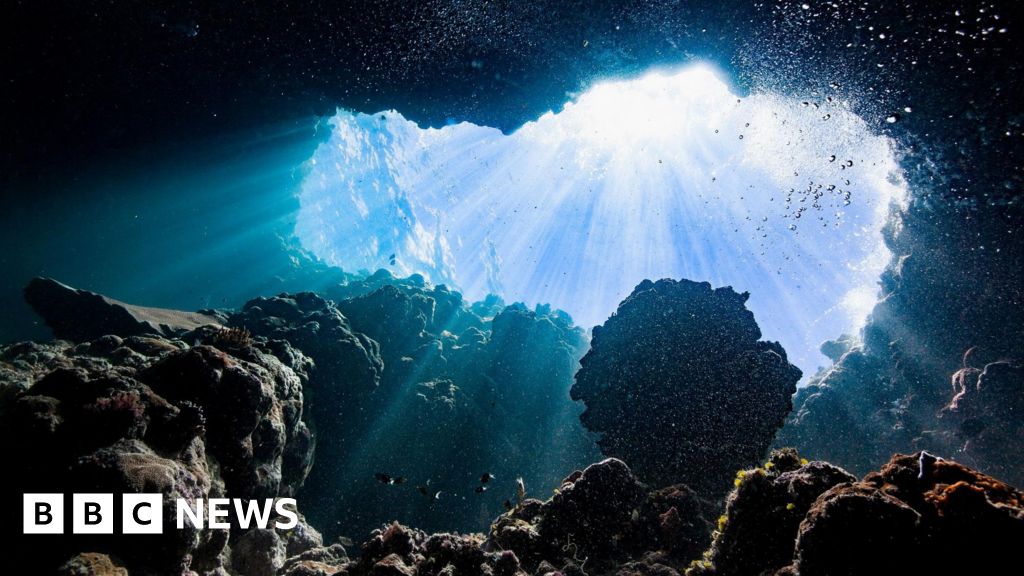Image source, Getty Images
Scientists have discovered that “dark oxygen” is being produced in the deep ocean by metal chunks on the seafloor.
About half of the oxygen we breathe comes from the ocean, but prior to this discovery it was understood that oxygen was produced by marine plants through photosynthesis, which requires sunlight.
Here, at a depth of 5km where sunlight does not reach, oxygen appears to be produced by natural metal “nodules” that split seawater (H2O) into hydrogen and oxygen.
Some mining companies plan to collect these nodules, but marine scientists worry that this could interfere with the newly discovered process and harm marine life that depends on the oxygen they produce.
Image source, NOC/NHM/NERC SmartX
“I first saw this in 2013, seeing huge amounts of oxygen being produced on the ocean floor in complete darkness,” explains lead researcher Professor Andrew Sweetman, from the Scottish Institute for Marine Science. “I’d been taught that oxygen could only be obtained through photosynthesis, so I ignored it.”
“In the end I realised I had been ignoring this potentially huge discovery for years,” he told BBC News.
He and his colleagues conducted their research in the deep ocean between Hawaii and Mexico, part of a vast seafloor covered in these metallic nodules. The nodules form when metals dissolved in seawater collect on pieces of shells and other debris, a process that takes millions of years.
These deposits contain metals such as lithium, cobalt and copper, all of which are needed to make batteries, so a number of mining companies are developing technology to collect them and bring them to the surface.
But Prof Sweetman says the dark oxygen they produce could also support life on the sea floor – and his findings, published in Nature Geoscience, raise fresh concerns about the risks of proposed deep-sea mining operations.
Image source, Science Photo Library/NOAA
The scientists concluded that the metal nodules could actually produce oxygen by acting just like a battery.
“When you put the battery in seawater, it starts to bubble,” Professor Sweetman explains, “That’s because the electric current is splitting the seawater into oxygen and hydrogen. [which are the bubbles]We think that’s what happens when these nodules are in their natural state.”
“It’s like batteries in a flashlight,” he added. “If you put one battery in, it won’t light up. If you put two in, you get enough voltage to turn on a flashlight. So when the nodules are touching each other on the ocean floor, they’re acting like multiple batteries working together.”
The researchers tested this theory in the lab by studying a collection of potato-sized chunks of metal, measuring the voltage, or strength of the electric current, on the surface of each chunk and finding that it was roughly equal to the voltage of a typical AA battery.
This means that nodules on the ocean floor could potentially generate enough electrical current to split, or electrolyze, seawater molecules, the researchers say.
The researchers believe that the same process of battery-powered oxygen production, requiring neither light nor biological processes, may occur on other moons and planets, creating oxygen-rich environments in which life can thrive.
Image source, Camille Bridgewater
The Clarion-Clipperton field where it was discovered is already being explored by a number of seafloor mining companies, who are developing technology to collect the nodules and transport them to ships on the surface.
The National Oceanic and Atmospheric Administration has warned that seafloor mining “can lead to the destruction of biological and seafloor habitats in the mined areas.”
More than 800 marine scientists from 44 countries Signed the petition They are highlighting the environmental risks and calling for a moratorium on mining activities.
New species are constantly being discovered in the deep ocean — it’s often said that we know more about the surface of the moon than we do about its deep oceans — and this discovery suggests that the nodules themselves may be providing the oxygen that supports life there.
“There is now overwhelming evidence that surface mining of deep sea nodules would destroy ecosystems that we barely understand,” Professor Murray Roberts, a marine biologist at the University of Edinburgh and one of the scientists who signed the seafloor mining petition, told BBC News.
“These fields cover such a large area of the Earth that it would be foolhardy to pursue deep sea mining knowing that they could be a significant source of oxygen production.”
“We don’t see this research as an end to mining,” Prof Sweetman added.
“[But] “We need to investigate further and use this information and the data we gather to help us dive deeper into the ocean and mine in the most environmentally friendly way possible.”


